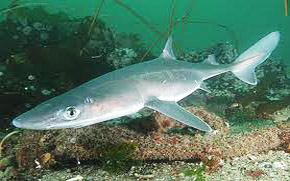Spiny dogfish shark
Common Name: Spiny dogfish shark
Scientific Name: Squalus acanthias

Introduction
Spiny dogfish abundance is rising, and overfishing is no longer taking place. Dogfish are no longer overfished. There is currently no large-scale, directed commercial fishery for spiny dogfish in the U.S. Small-scale directed fishing is permitted in east coast state waters. In federal waters, dogfish are only landed in fisheries that are targeting other species of fish and through recreational fishing. Shark is a low-fat source of protein and is high in selenium and vitamins B6 and B12. Shark may contain amounts of methylmercury in excess of the FDA's recommended limit for moms, moms-to-be, and young children. For more information, see EPA and FDA advice on what you need to know about mercury in fish and shellfish.
Life History and Habitat
Life history, including information on the habitat, growth, feeding, and reproduction of a species, is important because it affects how a fishery is managed. Since sharks take many years to mature and only bear a small number of live young after a long gestation period, they are especially vulnerable to overfishing. Directed fisheries for mature females appear to have had a significant impact on recruitment. NMFS has ended the directed fishery in federal waters to rebuild the stock.
Geographic range: In the western North Atlantic from Greenland to Argentina (but most abundant from Nova Scotia to Cape Hatteras); in the eastern Atlantic from Iceland and the northern Russian coast to South Africa, including the Mediterranean and Black Seas. Also in the western Pacific Ocean, from the Bering Sea to New Zealand and in the eastern Pacific, from the Bering Sea to Chile.
Habitat: Dogfish prefer temperatures from 45 to 55 degrees Fahrenheit. They are located inshore and offshore of the continental and insular shelf and upper slopes and are usually found near the bottom (but also in mid-water and at the surface). Dogfish are often found in enclosed bays and estuaries.
Life span: Dogfish are long-lived - males live up to 35 years and females live up to 40 years.
Food: Spiny dogfish eat a wide variety of prey. Herring, mackerel, squid, silver hake, and comb jellies constitute the major portion of their diets. Cod, haddock and flatfish are relatively uncommon by comparison. Spiny dogfish also prey on flatfishes, blennies, sculpins, jellyfish, polychaetes, sipunculids (group of marine worms), amphipods (small, shrimp-like crustaceans), shrimp, crab, snails, octopods, squids, and sea cucumbers.
Growth rate: Slow; females grow larger then males
Maximum size: Males grow up to 3.3 feet, and females grow up to 4 feet.
Reaches reproductive maturity: Males reach maturity at 6 years and 23 inches; females reach maturity at 12 years and 30 inches.
Reproduction: Females each have 2 to 12 eggs per season. They bear live young, after a gestation period of about 18 to 24 months, and typically produce 2 to 15 pups, with an average of 6.
Spawning season: Winter
Spawning grounds: Offshore waters
Migrations: Related to water temperature. Dogfish are found in North Carolina and southern New England during spring and autumn but migrate northward to the Gulf of Maine-Georges Bank region and into Canadian waters in summer and southward in autumn and winter. Mature dogfish also school by size and sex.
Predators: Predators of dogfish include a variety of shark species including sixgill, sevengill, leopard, and great white; a variety of larger fishes such as lancetfishes and some rockfish; and some marine mammals.
Commercial or recreational interest: Both, although only recreational when preferred target species are unavailable
Distinguishing characteristics: Dogfish are slim, with a narrow, pointed snout and characteristic white spots. They have two dorsal fins with ungrooved large spines and are colored grey above and white below.
 Deep Sea Crabs
Deep Sea Crabs